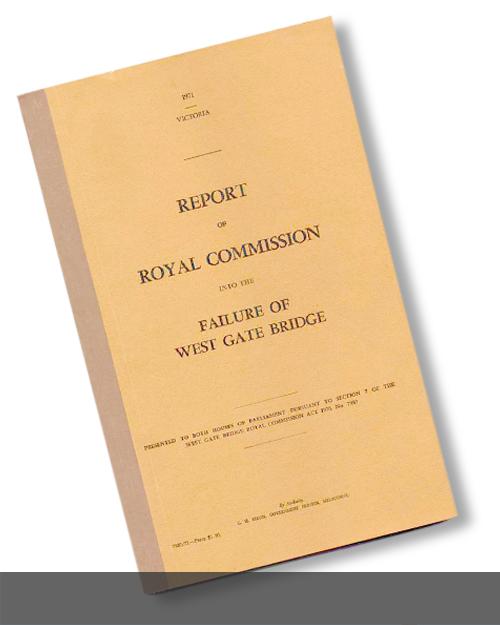The Royal Commission into the Failure of the West Gate Bridge, chaired by Mr Justice Barber, commenced on 28 October 1970 and concluded on 14 July 1971. The Commission completed collecting the evidence from 52 witnesses in May 1971, It had sat for 73 days - broken only for Christmas and Easter - and had listened to more than two million words of evidence.
The Commissioners took little more than a month to complete their weighty 300-page, 8000 word report, and it was released in the Victorian Parliament on 3 August 1971.
The introduction of the Report of the Royal Commission begins:
‘On The 15 October 1970, at 11:50 am, the 367-ft span of the West Gate Bridge, known as span 10-11, being one of the spans on the western side of the River Yarra, suddenly collapsed. There can be no doubt that the particular action which precipitated the collapse of span 10-11 was the removal of a number of bolts from a transverse splice in the upper flange plating near to mid-span. The bolts were removed in an attempt to straighten out a buckle which had occurred in one of the eight panels which constitute the upper flange. The buckle in turn, had been caused by the application of kentledge in an attempt to overcome difficulties caused by errors in camber.
To attribute the failure of the bridge to this single action of removing bolts would be entirely misleading. In our opinion, the sources of the failure lie much further back; they arise from two main causes.
Primarily the designers of this major bridge, FF & P (Freeman Fox and Partners) failed altogether to give a proper and careful regard to the process of structural design. They failed also to give a proper check to the safety of the erection proposals put forward by the original contractors, WSC (World Services and Construction Pty Ltd). In consequence, the margins of safety for the bridge were inadequate during erection; they would also have been inadequate in the service condition had the bridge been completed.
A secondary cause leading to the disaster was the unusual method proposed by WSC for the erection of spans 10-11 and 14-15. This erection method, if it was to be successful, required more than usual care on the part of the contractor and a consequential responsibility on the consultants to ensure that such care was indeed exercised. Neither contractor, WSC nor later JHC (John Holland & Co), appears to have appreciated this need for great care, while the consultants FF & P, failed in their duty to prevent the contractor from using procedures liable to be dangerous.’
Extract from ‘West Gate’ by Bill Hitchings
Download the Report of Royal Commission into the failure of West Gate Bridge

